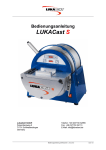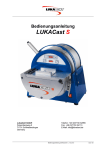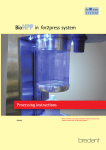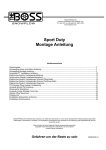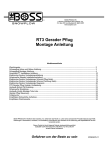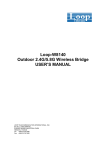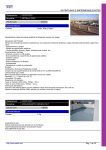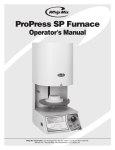Download Sharp PC-MC20 Instruction manual
Transcript
Instruction Manual for Bench Top Casting Unit MC20V Contents 1. Introduction........................................................................................................ 3 1.1. General description of the MC20V................................................................. 3 1.2. Machine components .................................................................................... 4 1.3. Technical Data .............................................................................................. 5 1.4. General information ....................................................................................... 6 2. Putting into operation......................................................................................... 9 2.1. Set-up directions............................................................................................ 9 2.2. Mains supply ................................................................................................. 9 2.3. Cooling water ................................................................................................ 9 2.4. Protective Gas ............................................................................................. 10 2.5. Vacuum Pump............................................................................................. 10 3. Operation......................................................................................................... 11 3.1. Components ................................................................................................ 11 3.2. Connections on the backside ...................................................................... 12 3.3. Operation elements ..................................................................................... 13 3.4. Operating buttons ........................................................................................ 17 3.5. Inside the vacuum chamber ........................................................................ 18 3.6. Different crucibles........................................................................................ 18 3.7. Test running ................................................................................................ 19 3.8. Casting programs MC20V ........................................................................... 20 3.9. A suggestion for a general casting process:................................................ 20 3.10. Important information about direct induction heating................................ 21 3.11. Temperature Control ................................................................................ 22 3.12. Tree making ............................................................................................. 22 3.13. To find out the weight of the metal .......................................................... 24 3.14. About casting metal:................................................................................. 25 3.15. Hints for castings in difficulty-to-cast metals............................................. 25 3.16. Casting temperatures ............................................................................... 27 3.17. Mixing instructions for flasks in Investing process .................................... 28 3.18. Determining volumes of investment powder and water for Investment . 29 3.19. Burnout cycles of flasks............................................................................ 30 3.20. After casting: ............................................................................................ 33 4. Service............................................................................................................. 34 4.1. Trouble shooting.......................................................................................... 34 4.2. Maintenance................................................................................................ 34 5. Collection of Spoiled Castings ......................................................................... 35 6. Connection diagram......................................................................................... 41 7. Appendix.......................................................................................................... 42 7.1. CE-declaration............................................................................................. 42 7.2. Consumables .............................................................................................. 43 7.3. Error and Warning Codes............................................................................ 45 OPERATING_MANUAL_MC20V.DOC 18.03.11 KS Seite 2 1. Introduction 1.1. General description of the MC20V The INDUTHERM mini casting machine MC20V is suitable to cast all kind of metals into moulds or into investment flasks. Except dental alloys and very reactive alloys like Magnesium. The melting charge is heated up by induction. The special advantage of strong inductive heating is that the melting temperature is reached rapidly, because the heat is directly generated in the metal or will transported to the metal by a crucible with graphite insert. During the melting process, the metal is thoroughly mixed by means of a magnetic field, ensuring a homogenous mixing even when using mixtures of pure metals. Crucibles with graphite inlet are used for metals up to 1300°C, Ceramic crucibles for steel or Platinum up to 2000°C Vacuum-Pressure mode in only one chamber The casting mode is based on this new method: during the melting process the metal and the flask are under full vacuum. The metal is poured into the flask by tilting the whole chamber. Inside flask is also a vacuum which guarantees pouring without air counter pressure. Now the vacuum will be replaced by gas overpressure rapidly: The pressure impulse (inside of the flask is still under vacuum!) ensures excellent form filling. The effect of vacuum in the flask and outside overpressure lasts for some time, long enough until metal is already solid. The most important fact of this system is quickly creating of vacuum and very fast pressure built-up in the system. To the evacuate chamber it needs a strong vac pump with 8 m³/h minimum, releasing vacuum + creating over pressure it needs a gas bottle with PRESSURE regulator (NEVER a flow regulator !!!). Short connection pipes make rapid pressure supply even better. All functions are linked with the turning of the chamber: immediately after pouring metal into the flask, over pressure comes automatically. As mentioned before, a pressure impulse on top of liquid metal, while inside there is still a vacuum, makes the good form-filling of this system. This means, the flask by itself is a reservoir of the vacuum. As smaller the flask, as less reservoir is there and pressure equalisation is quicker. In case of doubt (very delicate items) or form filling problems take one size bigger for the flask than necessary from aspect of dimensions OPERATING_MANUAL_MC20V.DOC 18.03.11 KS Seite 3 1.2. Machine components The machine consists of separate units built in a housing: Inside the housing, the following components are installed: - microprocessor controlled induction generator DM-type medium frequency transformer oscillation circuit capacities The front side: -operating panel for control of melting cycles The rear side -on rear side, under a black plastic cover: interface RS232 for service The casting chamber consists of: -inductor, crucible, insulation parts, thermocouple OPERATING_MANUAL_MC20V.DOC 18.03.11 KS Seite 4 1.3. Technical Data MC20V Crucible temperature 15 cm 3 (ceramic crucible) 10 cm³ (with grafite inlay) max. 2000 °C Melting performance 3.5 kW Mains supply 230 V / 16 A, 50 or 60 Hz Cooling water supply 2.5 - 5 bar / min. 1,5 ltr./minute Cooling water recoil Pressureless Cooling water entry temperature 10 - 20 °C Protective Gas Argon oder Nitrogen, 8 bar Vacuum min. 8m³/h, 0,1 mbar abs. Ambient temperature 10 - 35 °C Relative atmospheric humidity 20 - 80 % Weight Crucible volume ca. 27 kg Dimensions (width x depth x height) 400 x 400 x 450 mm OPERATING_MANUAL_MC20V.DOC 18.03.11 KS Seite 5 1.4. General information Safety information In order to ensure a constant, ideal performance of the machine and to ensure safe working conditions, the user is to observe the following safety measures: The complete electrical wiring is to be performed only by qualified and specially trained personnel. Check the machine and the supply devices regularly on possible damages. Keep your fingers away from moving parts Before you use unknown material for your process, you must fulfil a risk analysis If you use process material that develop toxic gases, the machine outlet "Gas out" must not be release into the enviroment. It is not allowed to melt flammable material or material which develops under thermal influence gas, which creates an explosive atmosphere. Before you melt material like used medical implants a risk analysis must be performed. Additional the user must operate with personal safety equipment like rubber gloves and face mask. The cover of the inductor housing must be in horizontal possition all the time The mains at the house must be easy accessible. When opening cabinet/housings or when removing parts (exception: when this is possible by hand), certain parts under electric power can cause danger. If opening up the machine is necessary (before maintenance, change of machine settings, repair or exchange of parts) the machine must be cut off the mains voltage. If working on the opened machine is inevitable, only qualified trained personnel aware of the danger caused hereby and aware of the relevant regulations may be instructed to do this work. Capacitors in the machine can still be charged even when the machine’s mains supply is switched off. When it seems that the machine can no longer be worked safely it has to be taken out of production and secured against further unintentional use. The following incidents indicate that safe working is no longer possible: - the machine is visibly damaged - the machine does not function - uncommonly heavy wear from transportation OPERATING_MANUAL_MC20V.DOC 18.03.11 KS Seite 6 The safety valves placed inside the machine housing may not be removed, closed or altered in any way. As melted metal is processed with this machine (= temperatures up to 2000 °C), the utmost care and attention has to be applied when working with the Machine. The following necessary safety clothing is principally to be worn: - fireproof clothes - fireproof closed shoes - fireproof gloves - safety goggles Special caution is essential when working with graphite crucibles and graphite dies because these are only visibly hot at temperatures above 500°C! In commercial enterprises the regulations for the prevention of accidents of the relevant authority for electrical machinery are to be followed. People with pacemakers must not be near the machine while it is running. A trained responsible personnel is to supervise work with this machine. Before you start using the machine, the manual of the MC20V must be read and comprehended. OPERATING_MANUAL_MC20V.DOC 18.03.11 KS Seite 7 Use as determined/liability This casting machine is designed and manufactured to comply with the latest technical knowledge and according to approved safety regulations. When not putting into operation correctly or not using the machine as determined, however, danger and damages may occur. Therefore we suggest reading carefully and completely this manual before putting the machine into operation and to follow the instructions given there: This machine is only to be used for melting, casting of precious metals normally used for the production of jewellery. This machine may only be connected as mentioned in this manual. The mains supply as well as in- and outgoing pressures are to be provided as stated on the machine label. This machine was designed for use in closed spaces (indoors) and may only be used for the above-mentioned purpose. Only original INDUTHERM consumable and spare parts are to be used. The machine may not be modified in any way. Technical changes may only be effected with INDUTHERM GmbH’s prior written permission. Damages caused by disregard or false interpretation of the contents of this instruction manual result in an immediate expiration of the machine guarantee. This instruction manual is conform to the latest technical condition of the machine when printed. Technical changes and fittings subject to change. INDUTHERM GmbH cannot and will not take responsibility for any damages resulting of the above mentioned. This instruction manual may not even partially be reproduced (photocopy, micro film, computer processing etc.) without prior written permission of INDUTHERM GmbH. OPERATING_MANUAL_MC20V.DOC 18.03.11 KS Seite 8 2. Putting into operation On delivery, immediately check if the machine is complete and if there are any transportation damages. In the case of damages, please contact at once supplier or forwarding agent. 2.1. Set-up directions The machine should be placed on clean and dry ground. The ground should be even, solid and level. The rear side of the machine must remain freely accessible to ensure sufficient circulation of cooling air. The cooling air temperature must not exceed 35°C and must not be contaminated. Only after all supply and connecting systems have been connected, the machine may be put into operation. 2.2. Mains supply Only trained personnel may connect the machine. Please pay attention to the nominal voltage and frequency stated on the machine label. The 1-phase current may differ +/- 10% (maximum) from the nominal value. The mains supply must at least be furnished with 20 A delay-action fuses (at 1* 230 V AC). The machine is equipped with a 16 A- -connector when leaving INDUTHERM. All 3 lines (L1, N, PE) must be connected correctly. Please take notice, that MC20V needs its own power line from breaker. Do not connect other machines on this power line. . 2.3. Cooling water Use two hoses with an outer ø of 6 mm for the cooling water. The water entry pressure must be at least 2.5 bar and must not be more than 5 bar. The water drainage must be without pressure. The water entry temperature must be above 10°C and must not exceed 25°C. The concentration of lime in the water must not be more than 60 mg CaO/l. The cooling water must not be contaminated. Caution: As long as the crucible temperature is above 100°C, the cooling water supply must be open; otherwise the inductor insulation could be destroyed. In case the cooling water supply stops while there is still a hot crucible inside the machine, the crucible must be removed immediately. OPERATING_MANUAL_MC20V.DOC 18.03.11 KS Seite 9 2.4. Protective Gas The connection of inert gas supply is done by a hose with outside diameter 8 mm. Primary pressure should be 6-8 bars. Regulator on the gas bottle is a pressure regulator (NEVER use a flow regulator !!!) This armature must be purchased at a serious dealer for gas bottles. Ask him! To purchase this armature at Indutherm: difficulty because all countries have different standards in gas bottles. If only platinum or other non-reactive metals has to be casted: it is in general possible to use pressurized air. For standard applications you can use nitrogen gas For application in Pd 950-alloy it is a must to use good quality argon gas! This gauge must show bar/PSI but NOT Liters / Minute 2.5. Vacuum Pump The vacuum pump should be connected with the supplied tube with an outer ø of 8 mm. Keep the vacuum tube as short as possible to avoid pressure loss. Before starting unit: let vacuum pump run for 10-15 minutes to heat-up oil (Inlet closed). Same after finishing casting: let it run for 10 minutes more (inlet closed). This is specially important if vacuum pump is running also for Investment Unit! Water steam/moisture makes a mixture with oil (emulsion) which makes the oil disable. OPERATING_MANUAL_MC20V.DOC 18.03.11 KS Seite 10 3. Operation 3.1. Components 4 5 1 6 7 2 3 Abb. 1: 8 front view Position 1 2 3 Description function tilting handle with due to movement to the right the machine will lock cast allows temperature measurements above pyrometer 1300°C inductor housing the melting and casting process takes place here 4 LCD screen see 3.3 5 control buttons see 3.4 6 top plate with handle locks the inductor housin 7 lock locks the system for safety reasons and to allow overpressure 8 main switch machine will be turned on and off here OPERATING_MANUAL_MC20V.DOC 18.03.11 KS Seite 11 3.2. Connections on the backside 8 7 Abb. 2: Position 6 5 4 3 2 1 Backside of machine Description function 1 label label with serial number and technical data 2 air out exit for overpressure 3 protective gas input for protective gas 4 vacuum connection for external vacuum pump 5 water in input for cooling water 6 water out output for cooling water 7 mains cable electrical connection for machine 8 RS232 connection connection for PC or modem for service OPERATING_MANUAL_MC20V.DOC 18.03.11 KS Seite 12 3.3. Operation elements MC20V screen when starting the machine or "Temp. Edit" On the middle section shown: 100°C == actual temperature 1530°C == set temperature 0.00 bar == actual crucible pressure (-1 to 2 bars) 0.0 kW == actual heating power in kW 3.5 == maximum heating power 13 Program == active program with name "18ct yello" Manual == operation mode On the left side shown: Temp Temp + Power Edit == lower the set temperature even within a program == rise the set temperature even within a program == changes display to achieve temperature or power controlling (will change to temperature controlling ) On the right side shown: Program == go the the next program one place below (program 12) Program + == go the the next program one place higher Program setup == level to modify the selected program (here program 14) OPERATING_MANUAL_MC20V.DOC 18.03.11 KS Seite 13 MC20V modify program screen On the top level shown: 0013 program == selected program to modify 1530°C Temperature == set temperature inside the crucible 115% Pyrometer correction == allows you to adjust displayed temperature (if necessary) 100% Heating power == allows you to adjust displayed temperature (if necessary) 0000 Washing before heating == washing cycles before heating (starts with vacuum, then backfill to 0.0 bar with protective gas). Number display the cycles that will be done. Recommend for Paladium alloys (very reactive alloys) 0001 Washing while heating == washing cycles during the machine heats -0.90 bar Melting pressure == melting pressure set value in bell 00.5sec Casting pressure start == tilting angle to 2.00 bar casting pressure == casting pressure set value 0030 s Vibration == vibration time OPERATING_MANUAL_MC20V.DOC 18.03.11 KS Seite 14 On the left side shown: Arrow up Arrow down == active parameter (highlighted with white background) changes to the parameter one level above == active parameter changes to the parameter one level below ( here Pyrometer correction) On the right side shown: + == changes set temperature to 1001 == changes set temperature to 0999 Main page == display moves back MC20V modify system parameter If you start from the start page and you press“ Program setup“ for 5 seconds you get access to the system paramter. On the top level shown: 000:00015 == selected parameter == 000 value of parameter 00015: equals seven == pyrometer If you press “Arrow up” you get access to the parameter 001 and higher. By pressing “+” you change the value of parameter 000 to 1 OPERATING_MANUAL_MC20V.DOC 18.03.11 KS Seite 15 MC20V modify program screen second page If you press now „Service“ button you see the software ID, machine number and generator number. If you press now „Service“ button again you see the water flow and machine stat OPERATING_MANUAL_MC20V.DOC 18.03.11 KS Seite 16 3.4. Operating buttons MC20V buttons left and right side Manual area: Generator Vacuum pump == starts and stops heating ( if not operating in program ) == switches vacuum pump on and off Automatic area: Stop Start == stops active program == starts selected program Special function of "Start" button: If you are operating within a program cycle and melting pressure ist active, you can release and reactivate the melting pressure by pressing the start button. OPERATING_MANUAL_MC20V.DOC 18.03.11 KS Seite 17 3.5. Inside the vacuum chamber 4 3 2 5 1 Abb. 3: Position shown with graphite inlet Description Function 1 thermoelement type N allows a temperature measurement up to 1300°C 2 3 ceramic crucible with graphite inlet ceramic shield in this crucible the graphite contains the heat and transfers the energy to the metall protects the thermocouple against contamination with liquid metall or graphite 4 flask adapter adapter for variuos flasks and mould sizes 5 flask flask (here without investment) 3.6. Different crucibles Ceramic crucible with grafite inlet for precious metals #12279021 Ceramic crucible for Platinum And others high temperature alloys #12279011 Ceramic crucible for CrNi, CrCo und other steel alloys #12279020 Important: Use thermocouple for melting only in crucibles with graphite inlet. OPERATING_MANUAL_MC20V.DOC 18.03.11 KS Seite 18 3.7. Test running After setting-up MC20V according to our instruction manual, you should make a final countercheck before you start casting: Please check once more connection: Electrical Supply: Cooling water: Vacuum: Protective Gas: . Voltage supply according to label on machine? Plugged-in? Water tap is connected to Water In? Water tap open? Vac-Pump installed, plugged-in and switched on? Valve on bottle opened Reduction Valve on bottles shows 6-8 bars? After main switch on: If you start the first heating cycle, the MC20V does a self-test. The routine is checking vacuum and inert gas pressure. If vacuum is missing or system is leaking, error message E081 appears. If inert gas pressure is missing or too low, error message E083 appears. Everything is OK? If not contact us! Insertion of Crucible Crucible has no damages or cracks? Wool in glass shield? Insertion of thermocouple Thermocouple’s protection tube is mantled? In crucibles with graphite inlet: Tip of thermocouple touches graphite? If no thermocouple is used: do not forget to connect DUMMY-plug 13400022 Important: Use thermocouple for melting only in crucibles with graphite inlet. Otherwise induction energy will stimulate thermocouple directly (without protection by graphite). Result, read in display, is pure nonsense! OPERATING_MANUAL_MC20V.DOC 18.03.11 KS Seite 19 3.8. Casting programs MC20V Casting programs MC20V Version _02 since August 2011 Preprograms_MC20V_02 Graphite crucible with thermocouple reading Silver Yellow 935/Cu gold 18k Material Program No. Temperature* °C Pyrometer correction % Heating power % Washing before heating Washing while heating Melting pressure** bar Casting pressure start (in ° or ° seconds) Casting pressure bar Vibration sec Label * ** *** Ceramic crucible with holder and pyrometer reading 950Pt CrCo 950Pd stainl. steel 10 11 12 13 14 1000 0100 0050 0000 0000 -1.00 60° 1080 0100 0050 0000 0000 -1.00 60° 2000 0100 0100 0000 0000 -1.00 60° 2000 0115 0100 0000 0001 -0.90 60° 2000 0100 0100 0002 0000 -1.00 60° 2.00 0030 935/Ag 2.00 0030 750/YG 3.00 0030 950Pt 2.00 0030 CrCo 3.00 0030 950Pd Temperature: Please see the alloys data sheet for recommended casting temperature. Melting pressure: When the display shows “Melting”, the melting pressure can be applied at any time by pressing the “Start” button again. Casting should be as fast as possible. The temperature controlling takes too long. The casting needs to be done by vision. Once the material is liquid wait 5-10 seconds and then cast! 3.9. A suggestion for a general casting process: Open cooling water supply Open protective gas supply Switch on main switch Switch on vacuum pump ( the pump will no operate if you start it against full vacuum) Insert crucible with material into the quartz glass tube inside the inductor. Select the correct flask holder for your flask Place flask holder into the casting chamber. The holder can be fixed to keep flasks of 50-80mm length in 5mm steps. Place flask in the flask holder. Close and lock casting chamber. Select desired program. Press "Start" button Follow the instructions on the LCD screen If casting temperature is reached (see data sheet of manufacturer of the alloy) press the button on the handle to release and tilt the unit uninterrupted clockwise till the catch. Release the button on the handle to lock the unit in the tilted position. During the tilting the unit automatically switches from vacuum to overpressure inside the casting chamber. The generator stops. On the display "Time" a timer counts the seconds after casting. After a sufficient waiting time, unlock the handle and tilt the unit back to horizontal position. The vacuum inside the crucible chamber is released by protective gas to ambient pressure. OPERATING_MANUAL_MC20V.DOC 18.03.11 KS Seite 20 Open the casting chamber and remove the flask and the flask holder. 3.10. Important information about direct induction heating Direct induction melting is necessary on metals with high temperature melting points, such as Pt, steel etc. High temperatures do not allow use of graphite crucibles because of quick burning under standard atmosphere. Also direct induction melting is necessary on metals, which reacts unwanted with graphite. An Induction Coil, used in our systems, creates streamlines of electrical field, with an specific direction. Fieldlines on an induction coil If now a conductive material like metal is brought into this induction field, metal absorbs energy, it couples. This metal is separated in an unconductive ceramic crucible in between. As bigger now the working surface of the metal, as more energy can be absorbed, as quicker melting can happen. This is why metal parts should be placed rectangular to field line = horizontal, to provide optimal absorption of energy. So it makes sense to place metal plates horizontal, also bigger wires couple more energy in horizontal position. This is a typical application what does not work with a MC15. Here are 20g of small thin Platinum sheets. Miscues: - 20 grams of Platinum melt only as one piece - the material is standing vertical (IIII). Much better would lying horizontal (==) to cross fieldlines! Please take care that this metal parts have enough distance to crucible’s wall to prevent disruption of crucible by extension of the metal pieces before melting. Please also take notice, that induction melting systems need a certain amount of volume to absorb enough energy for melting. The MC20V with direct induction heating needs a filling level of at least 20% of the crucible’s volume. Thin wires, chipping do not have enough volume and should be compressed (by a press) or better, charged into already molten metal. At direct induction melting please notice following hint: If a too voluminous piece of metal will given to already molten metal, molten metal can „freeze“, it becomes solid again. If this form-fitting metal now is heated-up again, it expands can can disrupt the crucible. Hint: load complete amount of metal in cold crucible or charge only small pieces into molten metal OPERATING_MANUAL_MC20V.DOC 18.03.11 KS Seite 21 Caution: danger of squirting. 3.11. Temperature Control To use the temperature controller a thermocouple type N article no 13400010 up to 1300°C (parameter -01- must be set to 0002) * or type S article no 13000030 up to 1600°C (parameter -01- must be set to 0001) * Has to be connected to the socket inside the casting chamber. Very important is that you use the thermocouple together with the thermocouple protection cover article no 13200045. Important: Use thermocouple for melting only in crucibles with graphite inlet. Otherwise induction energy will stimulate thermocouple directly (without protection by graphite). Result, read in display, is pure nonsense! The nominal temperature can be set with the buttons "+" and "-". The heating power is now controlled by the temperature controller. If the temperature control is not in use (e.g. for temperatures above 1600°C, platinum alloys) the dummy plug must be connected to the thermocouple socket. The machine automatically switches to the manual heating power mode. The heating power can now be adjusted with the buttons "+" and "-" (display "P00" to "P100"). Without thermocouple, without dummy plug or with defective thermocouple the display shows "E041". Attention: Do not use a thermocouple in direct heating process! Energy will melt thermocouple! If you use graphite crucible and thermocouple the output power needs to be reduced to 50%. Otherwise the temperature overshoot is too high and will burn the thermocouple. 3.12. Tree making Pieces made of wax/plastic must be placed in „tree“ form. This is done by a small soldering needle + wax wire. On bigger trees for bigger machines there is a main wax sprue (ø 8-10 mm). OPERATING_MANUAL_MC20V.DOC 18.03.11 KS Seite 22 On this main sprue single pieces are fixed in a style of a spiral. This is best for cutting off the casting pieces after casting process. On MC20V this tree is more a bush, pieces are fixed on the button cone directly. Only a short piece of main sprue is required. This main sprue is fixed in the rubber base, the diameter of the rubber base is according to the diameter of the flask. Some hints: Make sprues as short as possible Diameter of sprues should be big enough to guarantee optimal feeding of the castings with liquid metal. Place wax pieces so that wax can flow out easily Not good good The connection of the waxes to the sprue should be done in a hydro-dynamic style, to prevent turbulences while pouring liquid metal. Liquid metal is heavy in weight, it can break away thin parts of the gypsum. Create all connections in hydro-dynamic proper style. Do not place waxes/plastic parts to close to flask cylinder. There should be a distance of at least 5 mm OPERATING_MANUAL_MC20V.DOC 18.03.11 KS Seite 23 3.13. To find out the weight of the metal ALL rubber bases must be determined on a scale. Write exact weight on this rubber bases by a felt pen. After mounting the tree, take the total weight. Deduct the rubber base weight from the total weight = net wax weight. To simplify matters we assume the specific weight of wax as 1. Metal weight is calculated by multiplying wax weight by the specific weight of the metal: Metal Water, wax Aluminium Steel Brass Bronze Silver Nickel silver Gold 333 Gold 585 Gold 750 Gold 900 Palladium 950 Platinum 950 Spec. weight g/cm³ 1,00 2,70 8,50 8,40 8,80 10,50 8,40 10,50 13,70 15,20 17,40 12,00 20,70 Example: Complete weight (wax + rubber base) 43,5g less weight of rubber base 38g = 5,5 g wax 5,5 g wax means Metal Silber Gold 750 Wax weight x Specific weight 5,5 g x 10,5 5,5 x 15,20 Metal weight 57,75 g 83,60 After the calculation: Place flask cylinder and fix it carefully on the rubber base. Do not touch wax pieces. OPERATING_MANUAL_MC20V.DOC 18.03.11 KS Seite 24 3.14. About casting metal: Because of high costs casters do not like to use every time fresh alloy. For some alloys customers mix „second hand metal“ up to 50%, mainly Au, Ag based alloys. Never use finished jewellery pieces. The alloy composition is not known, solder in casting material will give no good casting result. Never mix two alloys, even if they have the same contents of gold All already cast metal should be very clean, sand blasting and pickling are adequate methods. Caution: rest of glass beads, investment material or rests of acid are unwanted. Clean in ultrasonic in distilled water. Alloys with zinc content: give much more fresh metal to „old“ metal. Alloys with high carat (Pt 950, Au 21/22/24 ct) can be re-used to 100% Pd 950 is a very reactive metal. No chance to melt it twice. Use fresh metal! Prevent oxidation by melting under vacuum and inert gas only. Never use boric acid for melting! 3.15. Hints for castings in difficulty-to-cast metals Brass, gold 8/9/10 ct, some alloys gold 14ct These alloys have a high content of zinc. Some of the zinc evaporates during the heating phase. If vacuum is used in the melting chamber, much more zinc would evaporate. To prevent this problem there is a small trick: Put the metal in the cold crucible, set in flask at the same time. Push button start (heating) and start (vacuum) again immediately. Now a vacuum is built up, but the metal, still not liquid, cannot evaporate zinc. After reaching full vacuum, push another time start (vacuum will be released by gas). After reaching casting temperature, cast immediately. OPERATING_MANUAL_MC20V.DOC 18.03.11 KS Seite 25 Palladium 950 Platinum Palladium should be melted in the same type of crucible like Platinum. Palladium has a strong reaction with oxygen. That´s why we recommend to „wash“ the chamber atmosphere as follows: Set „power“ to zero “P000”. Put in metal, set in flask. Push button start (want to heat, but set point power is zero = no heating possible). After then start again = vacuum comes. After reaching vacuum, another push on start: vacuum will be released by ARGON gas. Make only ONE washing cycle! Change setting of power to power P100(%). Wait until metal is molten completely and cast immediately. IMPORTANT: Use Argon gas for palladium castings. Set heating power to P100 (100%). Use the special ceramic crucible for Platinium. Put metal into the (cold) crucible. Push “Start” once for heating, set in flask and lock chamber. Push “Start” second time to start the vacuum. Full vacuum is reached inside the gypsum in around 30 seconds (see timer) After metal is molten totally, wait for max. 8 seconds and cast. This will prolongate the life time of the crucible! Adjust your process in that way, that at the moment for poring out the Pt and the end of evacuation time (at least 30 seconds) of the flask are concurrently. Important hint: Pt, molten in a standard Pt-crucible, is absorbing silicate out of the crucible material. As more often you re-melt same batch of metal, as more silicate will be absorbed. This makes Pt brittle. Help: Coating of the inside of the crucible by use of liquid zircon oxide ! After casting: leave flask under set parameters for approx. 240 seconds. OPERATING_MANUAL_MC20V.DOC 18.03.11 KS Seite 26 Cobalt-chromium, steel alloys Set heating power to P080 (80%). Use the ceramic crucible for steel. Put in crucible, set in flask. Push “Start” twice to start heating and vacuum. If full vacuum is there for at least 30 seconds (see timer) increase heating power to P100 (100%) and cast when metal is ready. One more problem of NiCr, CoCr and steel alloys: some alloys tend to splash in molten condition and under vacuum. In this case it is useful to change setting of parameter P060 = limitation of vacuum. For standard application set of -21- is O. Setting of -21- into 1 means max. vacuum is –0.90bar, P060 into 2 means max. vacuum is 0.80bar. Please change back after casting to standard set! 3.16. Casting temperatures The casting temperature depends on metal alloy and style of castings: High melting point of metal needs high flask temperatures, thin and delicate pieces with long flow ways too. Low melting point of metal needs lower flask temperatures, heavier massive pieces too. Ask metal supplier about their recommendation. List of Recommended Flask Temperatures Metal Aluminium Silver 925 Y. gold 14 ct Y. gold 18 ct W. gold 18 ct W.gold 18 ct Pd Steel Palladium Platinum Melting point 720°C 980°C 950°C 1050°C 1150°C 1300°C Flask temperature in °C Pieces Pieces Pieces thin medium heavy 300 250 200 650 600 400-600 620 600 400-600 620 600 400-600 620 600 400-600 650 630 400-600 900 800 700 950 900 870 950 900 850 OPERATING_MANUAL_MC20V.DOC 18.03.11 KS Seite 27 3.17. Mixing instructions for flasks in Investing process Investment process means, that powder is mixed for a certain time with water in a special ratio into a slurry and filled into a flask. It is generally possible to do it by hand in an open rubber bowl. But during this process you will mix in air which creates bubbles afterwards in the investment and on top of the castings as well. Vacuum is required! After mixing by hand you can put the investment slurry into a vacuum for a short while to suck out air bubbles. After then fill slurry into a flask and place the filled flask into vacuum again, if possible on a vibrator. But this is a not really good way to make a proper investment: To mix air into slurry and suck it out after by vacuum is making no sense: prevent investment slurry against mixing in air = do whole mixing process under vacuum. Ratio of water/powder is given in instruction manual. Whenever slurry comes under vacuum, the boiling point of water comes down from 100°C to room temperature! Water steam comes out (you can see the bubbles in the slurry) and the ratio of the water: powder mixture changes. Mixing slurry, a working time is given for mixing and filling of flask. After then slurry has to get a rest to become solid without moving or vibration in a quiet place. If processing time takes too long, slurry already starts becoming solid during this phase. This will cause problems. The target is to mix slurry under vacuum, to fill slurry under vacuum into the flask under vibration and to release vacuum as soon slurry is in the flask. This is only possible in a system called investment mixing apparatus. After filling the flask: give slurry 1 hour time to become totally solid. No moving of the flask, place in on a quiet place without vibration. Afterwards: remove rubber base. Investment mixer for MC20V OPERATING_MANUAL_MC20V.DOC 18.03.11 KS Seite 28 3.18. Determining volumes of investment powder and water for Investment determining amount of powder per flask this formula is helpful: Volume of flask in ccm x 1,4 = amount of powder in grams For example flask ø 8 x 8 cm r² x x h x 1,6 = amount of investment powder in g 4² x 3,14 x 8 x 1,4 = 570 g Or on flasks ø 5 x 5,5 cm 2,5² x x 5,5 x 1,4 = 150 g This is gross weight, volume of cone and wax pieces must be subtracted! To find out proper the amount of water according to the instruction manual of investment material: Ratio, given by instructions: 100:40 100:40 = 570:x 40 x 643:100 = x = 228 g water Please take notice: More water makes investment material more permeable for gases = better form filling. If the manufacturer gives a mixing ratio 37 .. 39 : 100, use for filigree items 39:100, on standard items use 37:100! Make very precise measurement, use water with exact 20°C Too cold or too warm water can strongly change properties of the investment material like mixing time etc. Short cut: For standard MC20V flasks there are some recommendations: gypsum bonded investment powder like Goldstar XL, XXX, Kerr Satin Cast 20 etc. 100 : 40 powder : water flask size investment powder in grams water in ml mixing time in min:sec Ø 30mm x 55 mm Ø 50mm x 55 mm Ø 65mm x 55 mm Ø 80mm x 55 mm Ø 50mm x 80 mm Ø 65mm x 80 mm Ø 80mm x 80 mm 60 150 270 390 220 370 560 24 60 108 156 88 148 224 4:00 4:00 4:00 4:00 4:00 4:00 4:00 phosphate bonded investment powder like Goldstar Platincast, H.T. 100:35 OPERATING_MANUAL_MC20V.DOC 18.03.11 KS Seite 29 flask size investment powder in grams water in ml mixing time in min:sec Ø 30mm x 55 mm Ø 50mm x 55 mm Ø 65mm x 55 mm Ø 80mm x 55 mm Ø 50mm x 80 mm Ø 65mm x 80 mm Ø 80mm x 80 mm 60 150 270 390 220 370 560 21 52 95 136 77 130 196 3:00 3:00 3:00 3:00 3:00 3:00 3:00 3.19. Burnout cycles of flasks After investment process the flasks have to undergo a firing process. For this purpose the flasks have to be placed in the furnace with the button (opening) down to ensure a complete flow-out of wax. The firing cycle of gypsum bonded flasks has normally 3 phases: Phase 1. Melting out of wax and steaming out remaining moisture of flasks very slowly. This steaming out process should be done very gently to prevent gypsum against cracks. In case of the flasks for MC20V (comparatively small) we recommend to reach a temperature of 300°C (= ramp of 2,5°C/min) in 120 minutes. On bigger flasks we recommend to go to 150°C - 180°C in 120 minutes. Investment powder is a good insulator, that’s why the heat takes time to reach the core of the flask. To ensure that the flasks heat up homogeneous, let the flasks have a rest at the hold temperature of 30 minutes on small flasks and up for 60 minutes on bigger flasks. Phase 2 burning process of flasks. This process is similar to a sintering process: single particles bake together (bonding) and the investment material becomes much stronger. Gypsum bonded investment materials need 730°C for this bonding process. To reach this temperature starting at 300°C, ramp should be 4°C/min = process takes around 2 hours. On bigger flasks (starting at 150°C, we recommend to select ramp 5°C/min. Duration in the furnace: for small flasks like MC20V around 1 hour, on bigger flasks up to 5 hours. Phase 3 Bringing flasks to casting temperature. After reaching the casting temperature in the furnace, please give flask a rest of 30 – 60 minutes (depending on size) to ensure that set the temperature is also inside flask. For phosphate bonded investment material you can go, after phase nos. 2, directly to the final casting temperature for example 900°C. Give flask a rest at this temperature of 30-60 minutes at least, depending on the size of the flask. OPERATING_MANUAL_MC20V.DOC 18.03.11 KS Seite 30 Temp. 730 Casting temperature 300 2 3 5 6 time in h Firing cycle for MC20V, gypsum bound investment material This „gentle“ firing cycle needs around 7 hours, so from wax to casting it will take only one day. But it is also possible to push this cycle. Here a recommendation of a RAPID firing cycle: OPERATING_MANUAL_MC20V.DOC 18.03.11 KS Seite 31 Temp. 730 Casting temperature 300 0,5 1 1,5 2 3 time in h RAPID firing cycle for flasks MC20 gypsum bonded investment material Caution: In case of a „gentle“ firing cycle all amenities of the investment material are prevented from damage. A rapid firing cycle doesn’t take care on this amenities. Already aged investment powder or thus of lower quality can react because of gruff handling with cracks. In the dental field most people are using „SPEED“ investment material. The fresh invested flask can be set into the HOT furnace directly. After 1 hour the flask is ready for casting. Please ask a Dental Depot about this investment material. OPERATING_MANUAL_MC20V.DOC 18.03.11 KS Seite 32 3.20. After casting: Most castings in gold- and silver alloys, palladium- and platinum alloys can be quenched immediately after the 240 seconds cooling time in the machine. Except: stone in place castings, they should cool down to room temperature. However, some alloys need to cool for prolonged time, see datasheets of alloy suppliers. Castings in CoCr, NiCr and steel alloys should cool down to room temperature before removal of the flask. For flasks with gypsum bounded Investment material: Leave the flask 240 seconds after casting under over pressure. In this time you can be sure that even inside of the casting metal is solid. After this 240 seconds: Quench flask in water soon. Caution: For a stone-in-place-casting process: let cool down flask to room temperature! Otherwise stones will crack! For phosphate bonded investment material: Wait until flask has reached room temperature. Break investment by a hammer or so. Cleaning the tree For removal of the remaining plaster and oxidation skin, a sand blasting cabinet is very useful. Use of acid is dangerous and banned in most countries by government's law. Gypsum bonded investment: use of glass beads is good enough For phosphate bonded investment: it is better to use corundum. OPERATING_MANUAL_MC20V.DOC 18.03.11 KS Seite 33 4. Service 4.1. Trouble shooting MC20V does not start: Is the plug plug in? Fuse of the electrical circuit tripped? Otherwise MC20V will show information by an error code system in the display: Exxx There are two graduations: Warnings: will be displayed if something is wrong, but machine will not shut down. Errors: will shut down machine immediately to prevent system against serious damages. This warnings/errors are in a special list included in a list attached to generator documentation in the instruction manual. If an error message is not included this list please contact us. Attention: On our webside http://www.indutherm.de/errors.html you can find examples how to troubleshoot problems If you contact INDUTHERM or your dealer always provide serial no. or service no. of machine = This is necessary for us to give assistance 4.2. Maintenance A routine check/regular cleaning of the following is necessary. Caution: disconnect the machine first! Daily (before casting): Remove crucible and quartz glass tube, carefully clean inductor housing. Before reinstalling the above parts, check those and replace if necessary. Annually: Depending on the water quality, the cooling system should be cleaned with 25% citric acid. The cooling system should be treated with this acid for approx. 1 hour. Then clean the system thoroughly with pure water and check on eventual leakages. OPERATING_MANUAL_MC20V.DOC 18.03.11 KS Seite 34 5. Collection of Spoiled Castings Horizontal Flashing or Finning Cause Incorrect powder / water ratio (too much water). Work time of investment not used up. Remedy Using correct amount of water (especially important with vacuum investing machines). Ensuring the work time is used up and slurry temperature is 20 - 22ºC Other Flashing Or Finning Cause Work cycle too long. Investment beginning to set while still under vacuum. Disturbing the flasks too soon Heating too quickly during de-wax. Moulds allowed to dry out before burn out. Remedy Ensuring the work cycle is not too long and slurry temperature is 20 - 22ºC. Leave the flasks for at least one hour. Do not exceed 150ºC during de-waxing. If not burning out the same day, keep moulds wet by covering with wet sacking or plastic sheets. OPERATING_MANUAL_MC20V.DOC 18.03.11 KS Seite 35 Bubbles - Complete Spheres Cause Investment too thick. Too little water. Vacuum pump/ tank faulty. Work cycle too long. Investment beginning to set while still under vacuum. Remedy Use correct powder / water ratio. Ensure equipment is regularly serviced and adequate for the task. Ensuring the work cycle is not too long and slurry temperature is 20 - 22ºC. Bubbles-Incomplete Spheres Cause Static electricity on waxes. Grease or dirt on waxes. Remedy Use a wax wash. NOTE: THE WAX MUST BE COMPLETELY DRY BEFORE INVESTING. OPERATING_MANUAL_MC20V.DOC 18.03.11 KS Seite 36 Water marking Cause Incorrect powder / water ratio (too much water). Work time of investment not used up. Remedy Using correct amount of water. (Especially important with vacuum investing machines). Ensuring the work time is used up and slurry temperature is 20 - 22ºC. Gas porosity Cause Overheating the metal. Inadequate burn out. Flask overheated during burn out. Impurities in the metal. Remedy Reduce metal casting temperature. Increase the time at 730ºC. Ensure maximum burn out temperature does not exceed 730ºC. Do not use more than 50% recycled alloy and ensure it is clean OPERATING_MANUAL_MC20V.DOC 18.03.11 KS Seite 37 Rough Surfaces Cause Rough waxes. De-wax temperature too hot. Steam de-waxed for too long. De-waxed too quickly. Flasks overheated during burn out. Metal too hot. Remedy Use less release agent on the rubbers. Can be caused by excess talc. Do not exceed 150ºC during de-wax. Steam, de-wax for a maximum of 1 hour. Steam will erode surface of the investment. Leave flask for at least 1 hour to achieve maximum strength before de-waxing Ensure maximum burn out temperature does not exceed 730ºC. Reduce casting temperature. Inclusions Cause Improper sprues. Crucible break down. Dirty metal. Flasks overheated during burn out. Remedy Eliminate sharp corners in sprue system. Replace crucible. Do not used old, disintegrating crucibles. Do not use more than 50% recycled alloy and ensure it is clean Ensure maximum burn out temperature does not exceed 730ºC. OPERATING_MANUAL_MC20V.DOC 18.03.11 KS Seite 38 Incomplete castings Cause Metal or flask too cold. Improperly sprued. Incomplete burn out. Remedy Increase casting temperatures. If the metal or mould is too cold, the metal will freeze before completely filling the mould. The sprue system should be designed to allow the metal to enter easily and without restriction. Increase the burn out time at 730ºC. If the flask is not properly burnt out it will be impermeable and not allow gases to escape when the metal enters the mould. Shrinkage porosity Cause Incorrect sprue Flask temperature too low and sprue is incorrect. Remedy Sprues should be attached to the heaviest piece of the casting. There should be sufficient sprues to ensure the casting is adequately fed. The flask temperature should be just hot enough to achieve complete fill, according to the mass of casting OPERATING_MANUAL_MC20V.DOC 18.03.11 KS Seite 39 Blisters, Spalling Cause Flask being heated too rapidly during de-wax. Flasks overheated during burn out. Flasks put in furnace too soon after investing Remedy Do not exceed 150ºC during de-wax. Wax will boil and erode investment surface. Ensure maximum burn out temperature does not exceed 730ºC. Leave flasks undisturbed for a minimum of one hour before de-wax. OPERATING_MANUAL_MC20V.DOC 18.03.11 KS Seite 40 6. Connection diagram OPERATING_MANUAL_MC20V.DOC 18.03.11 KS Seite 41 7. Appendix 7.1. CE-declaration OPERATING_MANUAL_MC20V.DOC 18.03.11 KS Seite 42 7.2. Consumables The spare part list for this machine starts on next page. INDUTHERM is now using only machine specific spare parts lists, which contain all the information for your machine. The list is printed on the following pages. The name of the stored list starts with a 1.) G 2.) The next 5 digits are the machine number. 3.) Next is the specification for what application it is used for. (only at multipurpose machines) 4.) The version index. A new machine has the index _00. One example is G10120_ 00. This is the list of the machine serial no 10120 and the spare parts shown are for vacuum casting, index 00. We are pleased to send you this data on request as a PDF file G10120_ 00.pdf. This makes it easy for you to order the correct spare parts. If the list changes and the index get one step higher to _01 please save the old file _00 into a section “old” or delete it. If spare parts are replaced by new parts, the index will be incremented. This ensures that you always receive the latest version of consumables and spares. To be sure that the data is correct, INDUTHERM and their sales partners or end customers must work together. Besides of the standard spare parts we have additional files to support you accesory_parts_MC20V.pdf you can select flask adapters and ingots optional_spare_parts_MC20V.pdf shows consumables for different materials replacement_parts_MC20V.pdf the replacement parts of the machine Original INDUTHERM parts are clearly marked with our 3D hologram. For other spare or replacement parts please contact our sales partner for your country or our order department at the telephone no.: +49-7203-9218-40. OPERATING_MANUAL_MC20V.DOC 18.03.11 KS Seite 43 Bitte anstelle dieser Seite die aktuelle Verbrauchsteileliste und die Bilderliste der Verbrauchsteile einfügen ! / Replace this side with actual spare parts list G xxxxx = Serial number of machine OPERATING_MANUAL_MC20V.DOC 18.03.11 KS Seite 44 7.3. Error and Warning Codes The Error and Warning Codes for this machine start at next page. Attention: On our webside http://www.indutherm.de/errors.html you can find examples how to troubleshoot errors. Here you find PDF files with examples and pictures Attention: Warnings will not shut down machine! You can still operate machine, but inform us please. The software documentation for this DM - generator system has 7 digits and starts with 8000xxx. xxx = is the software index. Complete name "software_documentation_80000xx_customer.PDF" OPERATING_MANUAL_MC20V.DOC 18.03.11 KS Seite 45 History nicht mit Ausdrucken in PDF Somit nur Seite 1-45 drucken Date 01.09.11 User KS History Kopiert aus MC15+ Stand Aug 2011














































